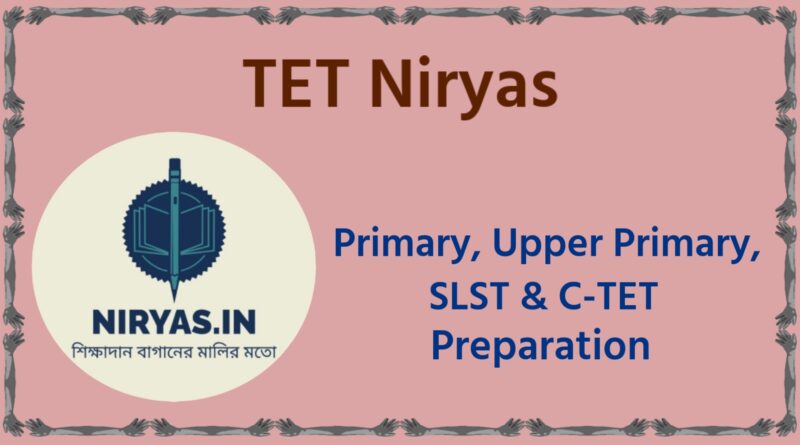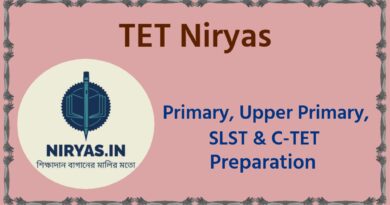Howard Gardner’s Theory of Multiple Intelligence
Howard Gardner’s Theory of Multiple Intelligences
The full meaning of the word TET is: Teacher’s Eligibility Test. According to the instructions of NCTE, currently, passing TET is one of the main conditions for employment in teaching from primary to higher secondary level. Keeping this in mind, we are highlighting our efforts to help competing students in the TET Niryas section, where Study Materials on the content of West Bengal Primary and Upper Primary TET, CTET Paper-I and Paper-II and SLST are available. Incidentally, the post called Howard Gardner’s Theory of Multiple Intelligences discusses various information about Gardner and his Theory :
Howard Gardner’s Theory of Multiple Intelligences
➲ Howard Gardner : Born : July 11, 1943, in Scranton, Pennsylvania. He studied psychology and philosophy at Harvard University, where he earned his Ph.D. in 1971. Gardner is currently a professor of education at Harvard University.
➲ Early Life and Education : Gardner was born in 1943 in Scranton, Pennsylvania. He grew up in a family of modest means and was raised by his mother, a musician, and his father, a businessman. Gardner earned his undergraduate degree from Harvard University in 1965 and his Ph.D. in psychology from Harvard University in 1971.
➲ Career, Research and Theory : Gardner began his career as a research assistant at Harvard University’s Project Zero, a research center focused on human cognition and education. He later became a professor of education at Harvard University and a senior director of Project Zero. Gardner’s research has focused on human cognition, education, and the nature of intelligence.
✦ Theory of Multiple Intelligences : Gardner’s most famous contribution is his theory of multiple intelligences, which proposes that there are multiple types of intelligence, rather than a single, general intelligence factor. He defines intelligence as “the ability to solve problems or to create products that are valued within one or more cultural settings.” Gardner has identified nine intelligences, including linguistic, logical-mathematical, spatial, bodily-kinesthetic, musical, interpersonal, intrapersonal, naturalistic, and existential intelligences.
➲ Main Idea : Howard Gardner’s Theory suggests that individuals possess multiple intelligences, which are relatively independent of one another. Each intelligence has its own strengths and weaknesses, and individuals may excel in one or more areas.
➲ Types of Intelligence : Gardner identifies nine types of intelligence:
➦ Original Seven Intelligences : Gardner initially proposed seven intelligences:
I. ✦ Linguistic Intelligence : The ability to use language effectively.
II. ✦ Logical-Mathematical Intelligence : The ability to reason abstractly and solve problems.
III. ✦ Spatial Intelligence : The ability to think in three dimensions and visualize objects.
IV. ✦ Bodily-Kinesthetic Intelligence : The ability to control body movements and manipulate objects.
V. ✦ Musical Intelligence : The ability to perceive, create, and appreciate music.
VI. ✦ Interpersonal Intelligence : The ability to understand and interact with others.
VII. ✦ Intrapersonal Intelligence : The ability to understand oneself and one’s own thoughts and feelings.
➦ Additional Intelligences : Gardner later added two additional intelligences:
VIII. ✦ Naturalistic Intelligence : The ability to understand and appreciate the natural world.
IX. ✦ Existential Intelligence : The ability to understand and contemplate abstract, philosophical ideas.
➲ Key Concepts :
✦ Multiple Intelligences :Howard Gardner’s Theory proposes that there are multiple types of intelligence, rather than a single, general intelligence factor.
✦ Domain-Specific Intelligence : Gardner’s theory proposes that intelligence is domain-specific, meaning that individuals may have different levels of intelligence in different areas.
✦ Intelligence Profiles : The unique combination of strengths and weaknesses in each individual’s multiple intelligences.
✦ Gardner’s Five Minds for the Future : A framework for cultivating five essential minds for success in the 21st century: the disciplined mind, the synthesizing mind, the creating mind, the respectful mind, and the ethical mind.
✦ Cultural Variability :Howard Gardner’s Theory proposes that intelligence is culturally variable, meaning that different cultures may value different types of intelligence.
➲ Applications : Gardner’s theory has significant Applications to many field, like
✦ Education : Gardner’s theory has been applied in educational settings to promote individualized instruction and to recognize the diversity of human intelligence.
✦ Psychology : Gardner’s theory has been used in psychology to understand the nature of intelligence and to develop new assessments of intelligence.
✦ Business : Howard Gardner’s Theory has been applied in business settings to promote diversity and to recognize the value of different types of intelligence.
➲ Implications for Education : Howard Gardner’s Theory has significant implications for education :
✦ Personalized learning : The theory suggests that individuals learn best when instruction is tailored to their unique intelligence profiles.
✦ Diverse assessment methods : Educators and employers should use diverse assessment methods to capture the full range of human intelligence.
✦ Emphasis on creativity and problem-solving : The theory highlights the importance of cultivating creativity, critical thinking, and problem-solving skills in individuals.
➲ Important Researchers :
✦ Howard Gardner : Gardner is the founder of the theory of multiple intelligences.
✦ Robert Sternberg : Sternberg is a psychologist who has developed a theory of successful intelligence that is similar to Gardner’s theory.
✦ Daniel Goleman : Goleman is a psychologist who has written extensively on the topic of emotional intelligence, which is one of the types of intelligence identified by Gardner.
➲ Future Research Directions :
✦ Empirical Support : Future research should focus on providing empirical support for Gardner’s theory, through studies and case analyses that examine the relationship between the different types of intelligence and real-world outcomes.
✦ Cultural Variability : Future research should focus on examining the cultural variability of Gardner’s theory, through studies that examine the different types of intelligence in different cultural contexts.
✦ Measurement and Assessment : Future research should focus on developing clear and reliable measures of the different types of intelligence, and on examining the relationship between these measures and real-world outcomes.
➲ Influence and Legacy : Gardner’s theory of multiple intelligences has had a significant impact on education and psychology. His work has influenced educators, policymakers, and researchers around the world. Gardner’s ideas have also been applied in various fields, including business, healthcare, and the arts.
প্রাথমিক টেট প্রস্তুতির জন্য ক্লিক করুনঃ
উচ্চ প্রাথমিক টেট প্রস্তুতির জন্য ক্লিক করুনঃ
➲ Criticisms and Limitations : Gardner’s theory has been subject to various criticisms and controversies, including charges of:
✦ Lack of Empirical Support : Gardner’s theory has been criticized for lacking empirical support, as it is based on a limited number of studies and case analyses.
✦ Too Broad : Gardner’s theory has been criticized for being too broad, as it attempts to explain all aspects of human intelligence rather than focusing on specific areas.
✦ Cultural Bias : Gardner’s theory has been criticized for being culturally biased, as it is based on Western cultural values and assumptions about intelligence.
✦ Lack of Clear Definitions : Gardner’s theory has been criticized for lacking clear definitions of the different types of intelligence.
✦ Difficulty in Measurement : Gardner’s theory has been criticized for being difficult to measure and assess, as there is no clear consensus on how to define and measure the different types of intelligence. Read : Computer Generations
➲ Publications and Awards : Gardner has written numerous books and articles on human cognition, education, and intelligence. Some of his notable publications include “Frames of Mind: The Theory of Multiple Intelligences” (1983), “The Unschooled Mind: How Children Think and How Schools Should Teach” (1991), and “Multiple Intelligences: New Horizons” (2006). Gardner has received numerous awards for his contributions to psychology and education, including the MacArthur Fellowship and the National Medal of Education.
➲ Books and Research Papers : Here are some notable books and research papers by Howard Gardner:
➱ Books:
⦿ “The Shattered Mind: The Person After Brain Damage” (1975)
⦿ “Artful Scribbles: The Significance of Children’s Drawings” (1980)
⦿ “Frames of Mind: The Theory of Multiple Intelligences” (1983)
⦿ “The Unschooled Mind: How Children Think and How Schools Should Teach” (1991)
⦿ “Multiple Intelligences: The Theory in Practice” (1993)
⦿ “Leading Minds: An Anatomy of Leadership” (1995)
⦿ “Extraordinary Minds: Portraits of Exceptional Individuals and an Examination of Our Extraordinariness” (1997)
⦿ “The Disciplined Mind: What All Students Should Understand” (1999)
⦿ “Intelligence Reframed: Multiple Intelligences for the 21st Century” (1999)
⦿ “Good Work: When Excellence and Ethics Meet” (2001)
⦿ “Changing Minds: The Art and Science of Changing Our Own and Other People’s Minds” (2004)
⦿ “Five Minds for the Future” (2006)
⦿ “Truth, Beauty, and Goodness Reframed: Educating for the Virtues in the 21st Century” (2011)
⦿ “The App Generation: How Youth Navigate Identity, Intimacy, and Imagination in a Digital World” (2013) – co-authored with Katie Davis
⦿ “A Synthesizing Mind: A Memoir from the Creator of Multiple Intelligences Theory” (2020)
➱ Research Papers:
⦿ “Frames of Mind: The Theory of Multiple Intelligences” (1983) – Harvard Educational Review
⦿ “The Theory of Multiple Intelligences” (1993) – Journal of Research in Science Teaching
⦿ “Multiple Intelligences: The Theory in Practice” (1993) – Educational Leadership
⦿ “The Unschooled Mind: How Children Think and How Schools Should Teach” (1991) – Phi Delta Kappan
⦿ “Leading Minds: An Anatomy of Leadership” (1995) – Leadership Quarterly
⦿ “Extraordinary Minds: Portraits of Exceptional Individuals and an Examination of Our Extraordinariness” (1997) – Journal of Personality and Social Psychology
⦿ “The Disciplined Mind: What All Students Should Understand” (1999) – Educational Leadership
⦿ “Intelligence Reframed: Multiple Intelligences for the 21st Century” (1999) – Journal of Educational Psychology
⦿ “Good Work: When Excellence and Ethics Meet” (2001) – Journal of Applied Developmental Psychology
⦿ “Changing Minds: The Art and Science of Changing Our Own and Other People’s Minds” (2004) – Harvard Business Review
➲ Conclusion : Gardner’s theory of multiple intelligences provides a comprehensive framework for understanding human intelligence and cognition. While the theory has been influential, it has also been subject to criticisms and limitations. Future research should focus on addressing these limitations and providing empirical support for the theory.Gardner is known for his passion for education and his commitment to making psychology and education more accessible and relevant to the general public.
⟽ Previous Post : Prominent Psychologist and Important Books


